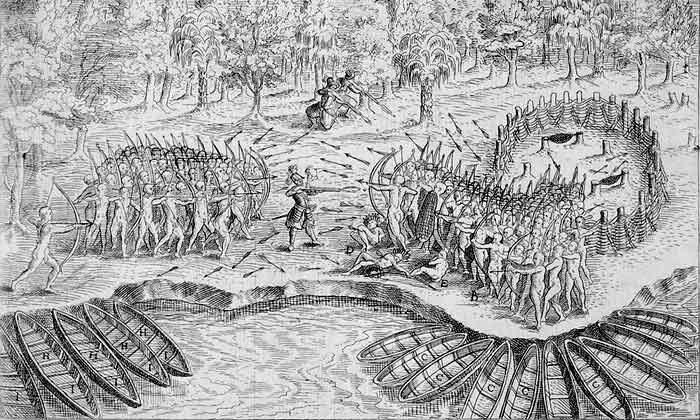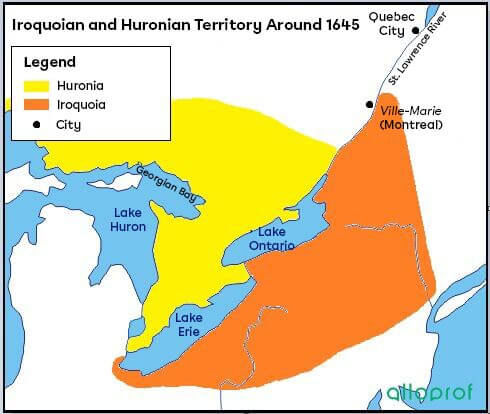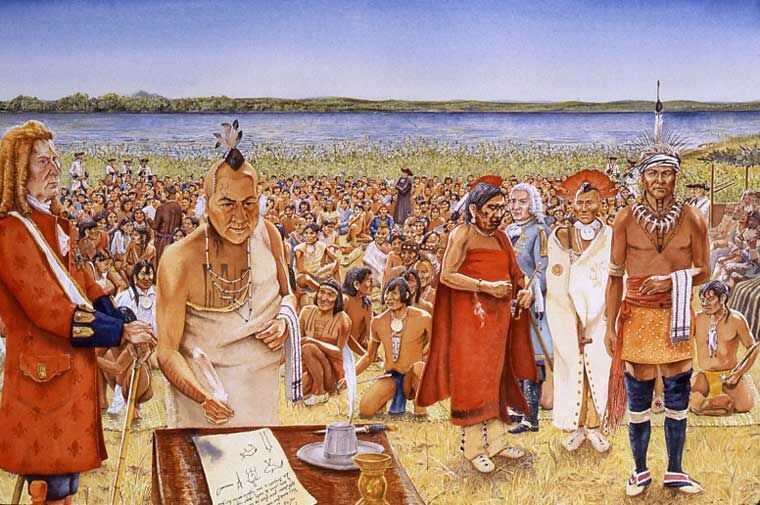As soon as they arrived, it was in the Europeans’ best interests to forge alliances with the Indigenous peoples, as they knew the land and its resources very well. However, these alliances, which were primarily commercial, led the French to become involved in conflicts and wars with some of the Indigenous nations.
In 1603, alliances between the French and Indigenous peoples formed in Tadoussac when Samuel de Champlain joined forces with the Montagnais (the Innus), the Maliseets (the Etchemins) and the Algonquins.
Then, in 1609, Champlain allied with the Hurons, who were important partners for the fur trade. When the French arrived, Huronia was already at the centre of a major Indigenous trading network. By forming an alliance with the Hurons, the French also agreed to provide military support against their ancient enemies: the Iroquoians from the Five Nations, who were trading with the Dutch.
The conflicts between the French, their allies and the Iroquoians were based in the control of the fur trade. Just as the French and their allies did, the Iroquoians also wanted to have the best furs to trade with their own allies, the Dutch, in exchange for European products. In 1609, the French and their Indigenous allies had their first battle against the Iroquoians.

Defeat of the Iroquoians at Lake Champlain, 1609
Attacks by the Iroquois Confederacy raged for many years. Instead of fighting, the French attempted to establish peace accords and secure the colony.
In 1641, the conflict grew more violent and from 1648 to 1650, the Iroquoians attacked Huronia. Weakened by epidemics and wars between the clans, the Hurons could not withstand the enemy attacks. To make matters worse, the Dutch provided arms to the Iroquoians, while the Hurons had very few since the French refused to trade arms with them. Many Hurons and Jesuits were killed and Huronia was destroyed.

After a ceasefire from 1653 to 1658, the Iroquoians returned to threaten the French settlements and their Indigenous allies in 1660.
At the end of the 1680s, the Iroquoians, who were now allied with the English, made renewed attacks against the French with several raids. These raids, which were rapid attacks, were a constant threat to the French colonies. The Iroquoians also tried to undo the alliance between the French and the Indigenous nations of the Pays d’en Haut. If they had managed to end this alliance, the Iroquoians, competitors to the French on the fur market, would have had more furs to exchange with the English.
In 1697, the French and the English made peace. The English no longer supported the Iroquoians’ conflict with the French, and they were weakened by the war and epidemics. The Iroquois wars ended with the Great Peace of Montreal in 1701. This peace treaty was signed in Montreal and brought together over forty Indigenous nations.
-
The Iroquoians agreed that the Indigenous peoples of the Pays d’en Haut could trade furs with the French.
-
The allies of the French and the English agreed not to intervene if there was a conflict between France and Great Britain.
-
The Governor General of New France was to play the role of mediator in any conflicts between Indigenous nations.
-
The Iroquoians made peace with the French and their allies.

Signature of the Great Peace of Montreal Treaty

The Great Peace of Montreal Treaty, we can see the signatures of the chiefs of the indigenous nations with their respective emblems.